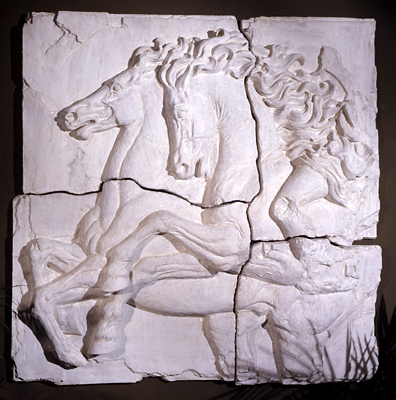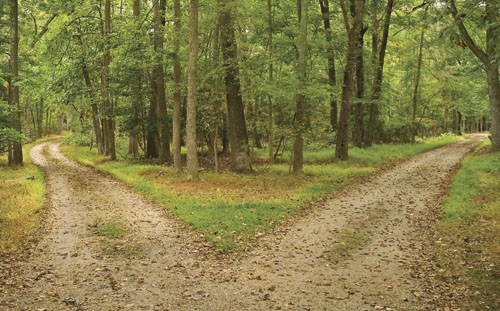
The Road Not Taken
Ojo is my daughter’s horse, gifted to her by her grandmother. Out of an AQHA stallion and an ApHC mare, Ojo did not have the good fortune to inherit a single spot from his leopard app dam. He was a rather ordinary looking sorrel colt with a gentle disposition and an affinity for my daughter, and so he was chosen from a group of five foals. Our daughter was very young at the time, and we had no illusions about this horse; she would not be able to ride him for many, many years. Her starter horse was Goose instead, and as she is still young (and madly in love with Goose) she has graciously agreed to “share” Ojo with her mother, who just so happened to be in need of a colt to start.
Saddle training began in earnest when Ojo was three. At the time, I had taken an interest in exploring training methodologies which were different from the way I knew to start a horse. I had purchasedTrue Unity, by Tom Dorrance, and Think Harmony with Horses, by Ray Hunt, and while I was intrigued by their words, I was also frustrated by the lack of technical descriptions in these books. It’s generally agreed these horsemen are considered founding fathers of the Natural Horsemanship I practiced, but the work I practiced, as did the other NH people I watched, bore little resemblance to the unity described in the books. It seemed their way had been abandoned in favor of chasing horses around little round pens and tormenting them with flags on sticks, and this was unsettling to me. Where is the unity, in chasing a horse away with a flag? I did not believe such methods were the ways of Dorrance and Hunt.
In True Horsemanship through Feel, by Bill Dorrance and Leslie Desmond, I found what I was seeking. In photos and text, the way of unity seemed revealed, and I understood this was what I had been seeking. Even more good fortune; although Bill had unfortunately passed, I found Leslie to be alive and teaching, and was ecstatic about the possibility of finding a live person to study with, to teach me the things the book could only hint at.
Then entered the problem of logistics; Leslie does not, and would not, be traveling anywhere near North Dakota. In fact, her website indicated she spent little time in the United States anymore, having moved to Europe. But I continued to follow her trail, and in Ohio, she had a student who wrote as eloquently as Leslie did, and I strongly suspected this student might be well enough familiar with Bill and Leslie’s work to warrant a visit. I was granted more good fortune, as Karen would be in southern Minnesota in a few short months, and that would put me a mere six hour drive away from the knowledge I was so hungrily craving. I registered for the clinic, and while I had already put some rides on three year old Ojo, I was eager to begin his fourth year as a better trainer, applying the newfound skills I would be learning from Karen.
By day two of the clinic, I recognized I had a serious problem. I had come, thinking I would be able to add some tools to my toolbox, some new techniques to make me a better trainer. I could not have been more wrong. To adopt the methods Karen was teaching was not a matter of adding some skills. To be able to really, truly, effectively use and benefit from anything Karen was teaching, I was going to have to do more than change this or add that. This was a radically different paradigm, way of approaching the horse, than anything I had ever experienced. This was not, “Here are some new things I can do with Ojo, to make him better.” This was, “Here is a new way of relating to the horse. If I want this, I will need to start over from scratch, as a horseman, and with this particular horse, from ground up. From the bottom.”
Saddle training began in earnest when Ojo was three. At the time, I had taken an interest in exploring training methodologies which were different from the way I knew to start a horse. I had purchasedTrue Unity, by Tom Dorrance, and Think Harmony with Horses, by Ray Hunt, and while I was intrigued by their words, I was also frustrated by the lack of technical descriptions in these books. It’s generally agreed these horsemen are considered founding fathers of the Natural Horsemanship I practiced, but the work I practiced, as did the other NH people I watched, bore little resemblance to the unity described in the books. It seemed their way had been abandoned in favor of chasing horses around little round pens and tormenting them with flags on sticks, and this was unsettling to me. Where is the unity, in chasing a horse away with a flag? I did not believe such methods were the ways of Dorrance and Hunt.
In True Horsemanship through Feel, by Bill Dorrance and Leslie Desmond, I found what I was seeking. In photos and text, the way of unity seemed revealed, and I understood this was what I had been seeking. Even more good fortune; although Bill had unfortunately passed, I found Leslie to be alive and teaching, and was ecstatic about the possibility of finding a live person to study with, to teach me the things the book could only hint at.
Then entered the problem of logistics; Leslie does not, and would not, be traveling anywhere near North Dakota. In fact, her website indicated she spent little time in the United States anymore, having moved to Europe. But I continued to follow her trail, and in Ohio, she had a student who wrote as eloquently as Leslie did, and I strongly suspected this student might be well enough familiar with Bill and Leslie’s work to warrant a visit. I was granted more good fortune, as Karen would be in southern Minnesota in a few short months, and that would put me a mere six hour drive away from the knowledge I was so hungrily craving. I registered for the clinic, and while I had already put some rides on three year old Ojo, I was eager to begin his fourth year as a better trainer, applying the newfound skills I would be learning from Karen.
By day two of the clinic, I recognized I had a serious problem. I had come, thinking I would be able to add some tools to my toolbox, some new techniques to make me a better trainer. I could not have been more wrong. To adopt the methods Karen was teaching was not a matter of adding some skills. To be able to really, truly, effectively use and benefit from anything Karen was teaching, I was going to have to do more than change this or add that. This was a radically different paradigm, way of approaching the horse, than anything I had ever experienced. This was not, “Here are some new things I can do with Ojo, to make him better.” This was, “Here is a new way of relating to the horse. If I want this, I will need to start over from scratch, as a horseman, and with this particular horse, from ground up. From the bottom.”

This was not an ultimatum, handed to me by Karen. This was my understanding of the ideas she presented, and was my decision to make. I could continue working horses the way I always had, the way I thought everyone did, and continue to get the same results we had always gotten. Or…I could reinvent myself as a horseman, become a beginner in a strange and foreign way of working, where I
knew there would be few who could help me and guide me. I would have to jump in the proverbial deep end, and learn to swim by myself, if I wanted to undertake the study of the things Karen presented. I lived too far from her to be able to depend on her ongoing support and instruction.
Essentially, I could continue being very good at being a poor horseman, or a complete novice at being a horseman of a vastly higher level. It was my decision to make.
Essentially, I could continue being very good at being a poor horseman, or a complete novice at being a horseman of a vastly higher level. It was my decision to make.
5.25.12 TME
Return to Educated Equestrian
Return to Educated Equestrian